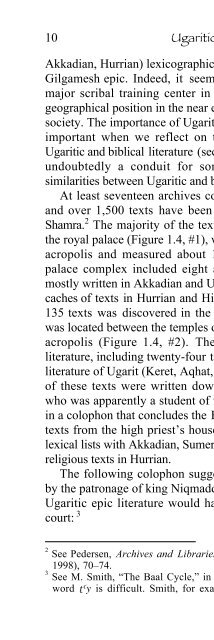A Primer on Ugaritic: Language, Culture, and Literature - enenuru
A Primer on Ugaritic: Language, Culture, and Literature - enenuru
A Primer on Ugaritic: Language, Culture, and Literature - enenuru
Create successful ePaper yourself
Turn your PDF publications into a flip-book with our unique Google optimized e-Paper software.
10<br />
<strong>Ugaritic</strong> <str<strong>on</strong>g>Primer</str<strong>on</strong>g><br />
Akkadian, Hurrian) lexicographic document, <strong>and</strong> a fragment of the<br />
Gilgamesh epic. Indeed, it seems likely that Ugarit served as a<br />
major scribal training center in the Levant because of both its<br />
geographical positi<strong>on</strong> in the near east <strong>and</strong> its cosmopolitan, affluent<br />
society. The importance of Ugarit as a scribal center is particularly<br />
important when we reflect <strong>on</strong> the significant parallels between<br />
<strong>Ugaritic</strong> <strong>and</strong> biblical literature (see §1.6). Such scribal schools were<br />
undoubtedly a c<strong>on</strong>duit for some of the literary <strong>and</strong> poetic<br />
similarities between <strong>Ugaritic</strong> <strong>and</strong> biblical literature.<br />
At least seventeen archives c<strong>on</strong>taining texts have been located<br />
<strong>and</strong> over 1,500 texts have been published from the site of Ras<br />
Shamra. 2 The majority of the texts from Ugarit were excavated in<br />
the royal palace (Figure 1.4, #1), which was located <strong>on</strong> the western<br />
acropolis <strong>and</strong> measured about 110 by 75 meters. The western<br />
palace complex included eight archives with over 1,000 texts<br />
mostly written in Akkadian <strong>and</strong> <strong>Ugaritic</strong>. The palace also had small<br />
caches of texts in Hurrian <strong>and</strong> Hittite. Another important cache of<br />
135 texts was discovered in the house of the High Priest, which<br />
was located between the temples of Ba‘al <strong>and</strong> Dagan <strong>on</strong> the eastern<br />
acropolis (Figure 1.4, #2). These texts were mostly religious<br />
literature, including twenty-four tablets c<strong>on</strong>taining the famous epic<br />
literature of Ugarit (Keret, Aqhat, Baal Cycle, <strong>and</strong> Rephaim). Some<br />
of these texts were written down by the famous scribe Ilimilku,<br />
who was apparently a student of the High Priest Attenu, as we see<br />
in a coloph<strong>on</strong> that c<strong>on</strong>cludes the Baal Cycle. Although most of the<br />
texts from the high priest’s house were in <strong>Ugaritic</strong>, there are also<br />
lexical lists with Akkadian, Sumerian, <strong>and</strong> Hurrian as well as several<br />
religious texts in Hurrian.<br />
The following coloph<strong>on</strong> suggests that Ilimilku was supported<br />
by the patr<strong>on</strong>age of king Niqmaddu, so that the compositi<strong>on</strong> of the<br />
<strong>Ugaritic</strong> epic literature would have been sp<strong>on</strong>sored by the royal<br />
court: 3<br />
2<br />
See Pedersen, Archives <strong>and</strong> Libraries of the Ancient Near East (Bethesda,<br />
1998), 70–74.<br />
3<br />
See M. Smith, “The Baal Cycle,” in UNP, 164, 176. The translati<strong>on</strong> of the<br />
word t{y is difficult. Smith, for example, takes it as a gentilic, i.e., “the


